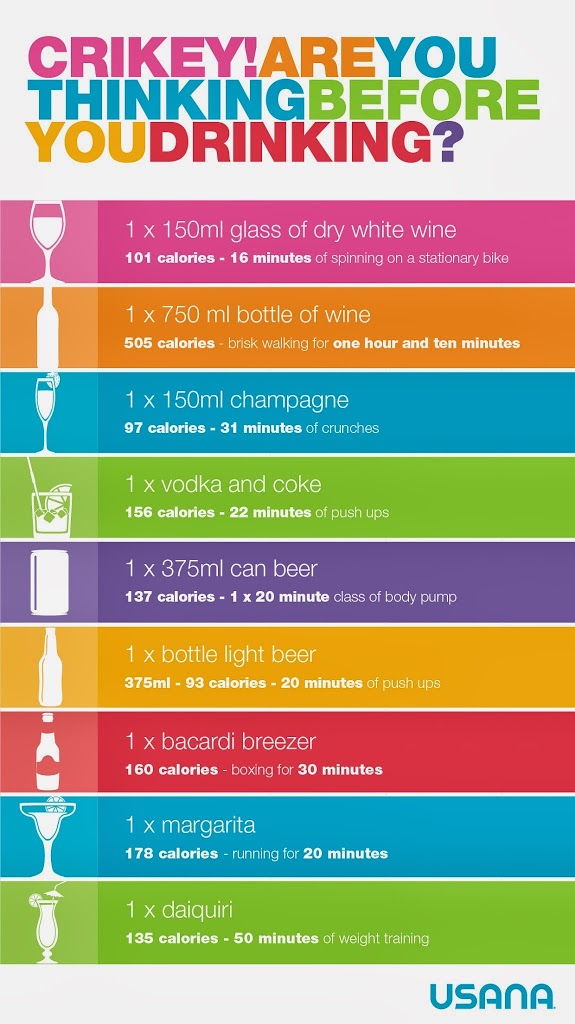
By Ravinder Lilly
USANA ANZ Writer and Dietitian
OK don’t get annoyed with me for this one. You asked for the truth and the whole truth and here it is… If you just can’t understand why you’re not shifting the weight, it could be due that alcohol is holding back your best made weight-loss plans.
Let me explain…
Many of us enjoy a drink or two. But when you’re trying to lose weight, you may find that it’s best if you lay off it completely – or stick to just one drink per day.
That’s because alcohol is loaded with calories. At seven calories per gram, it’s second only to fat (which provides nine calories per gram).
Plus, when you add in the mixers/juices, the calorie load rises even higher. Another reason that alcohol can crank up the kilos is that it’s easy to drink a lot of it without it affecting your body’s satiety system. So, the calories can pile up and up. Then, the dehydrating effects of alcohol increase your blood pressure and slow down your metabolism. But, where your weight is concerned, there’s even more bad news…
When your body detects alcohol, it responds to the introduction of what is essentially a toxin by switching from fat metabolism in order to focus on getting rid of alcohol from your body. So instead of breaking down fats, not just the fats you’ve just eaten but the fats in your body, it concentrates on ridding itself of alcohol.
Putting the brakes on fat breakdown
One small study published in the American Journal of Clinical Nutrition involved eight men who drank two units of vodka and sugar-free lemonade. Each drink contained just under 90 calories. Fat metabolism was measured before and after drinking and then for several hours afterwards. Results showed that fat oxidation in the whole body (a measure of how much fat the body is burning) dropped by a massive 73 per cent!
Incoming fat…
So, while your body puts the brakes on breaking down fats that are already in your system, alcohol is also notorious for weakening your willpower especially for fatty, salty snacks (kebab anyone?). The slowed-down fat metabolism combined with incoming fat means that it’s easy to store fat in your body and in particular, around your liver and centrally around your body. Hence the infamous beer belly.
Beer belly AKA central obesity
This kind of central obesity or apple shape raises your risk for raised blood fats, hypertension, cardiovascular disease and developing type 2 diabetes. Studies suggest that people eat around 20 per cent calories from food more than normal whilst drinking alcohol either because it interferes with your body’s ability to feel full or perhaps due to sheer will power weakening effects. The kind of fat around your middle is also metabolically active – it located deep inside your body and is wrapped around your internal organs. Plus, this type of fat prevents may hinder the work of your pancreas (which secretes insulin) and liver (which detoxifies and cleans your body).
Are you a weekend binger?
And, if you’re one of those people who is careful with alcoholic drinks during the week but lets it all happen at the weekend, you could be downing thousands of calories without knowing about it! So that cheeky glass of wine after work which turns into a couple. And the drinks with dinner. And so on. Unless you add up exactly what you drink (and eat) into a journal, you won’t have an accurate idea of what you’re consuming (try easydietdiary.com or myfitnesspal.com).
Seeing the calorie counts linked with drinks (just as more and more restaurants are doing for foods) – and the exercise that you’d have to do to work them off – may help to make us more aware.
Tips on controlling alcohol intake:
Women should drink less alcohol because their bodies don’t break down alcohol as fast because women are generally smaller than men and naturally have a smaller liver which processes and detoxifies alcohol.
You don’t need to cut out alcohol altogether. Once you’re at your healthy weight range, enjoy what you enjoy. But don’t overdo it.
• Alternate sugar-free soft drinks or water with an alcoholic one
• Go for light versions where possible
• Water down wine with sparkling water or diet lemonade for a refreshing spritzer
• Never eat without having food in your stomach
• Keep water available to quench your thirst while you drink alcoholic drinks.
Are you sticking to within the Australian Alcohol Guidelines?
Men: A max of two drinks a day on average with two alcohol-free days a week.
Women: Two or less drinks a day on average with two alcohol-free days a week.
A standard drink explained
1 standard drink = 10g alcohol which is equivalent to:
• 100ml of table wine
• 30ml of spirits
• 250ml of beer
But one drink isn’t always just one drink!
• An average restaurant serve of wine of 180ml 12% Alc./Vol = 1.8 drinks
• A 375ml can of full strength beer 4.9%Alc./Vol = 1.5 drinks
• A 375ml can of pre-mix spirits 5%Alc./Vol = 1.5 drinks
Check the label to find out how many standard drinks in your serve.
Cheers!



This is outstanding information, Ravinder. Thank you very much! It’s interesting to see how alcohol affects us, and steps we can take to control intake. Love the infographic as well!